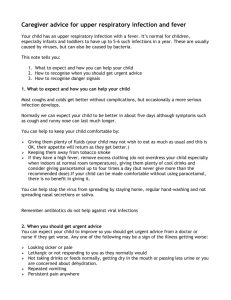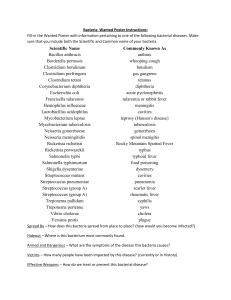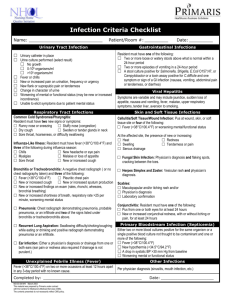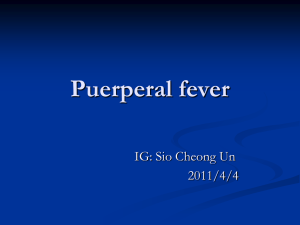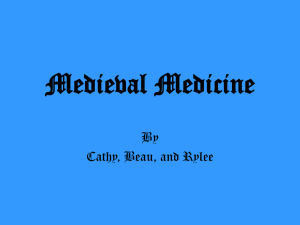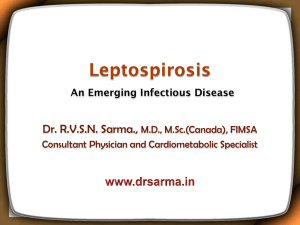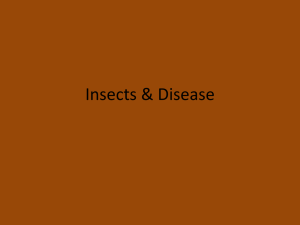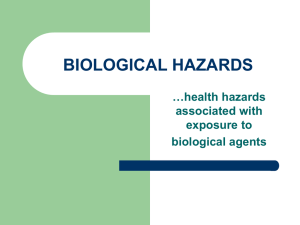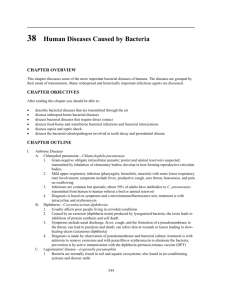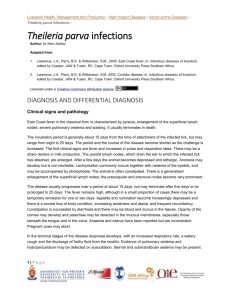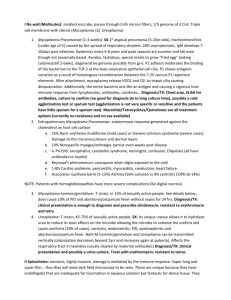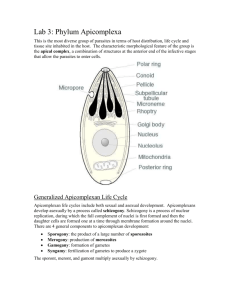Blood & Lymph Infections
advertisement
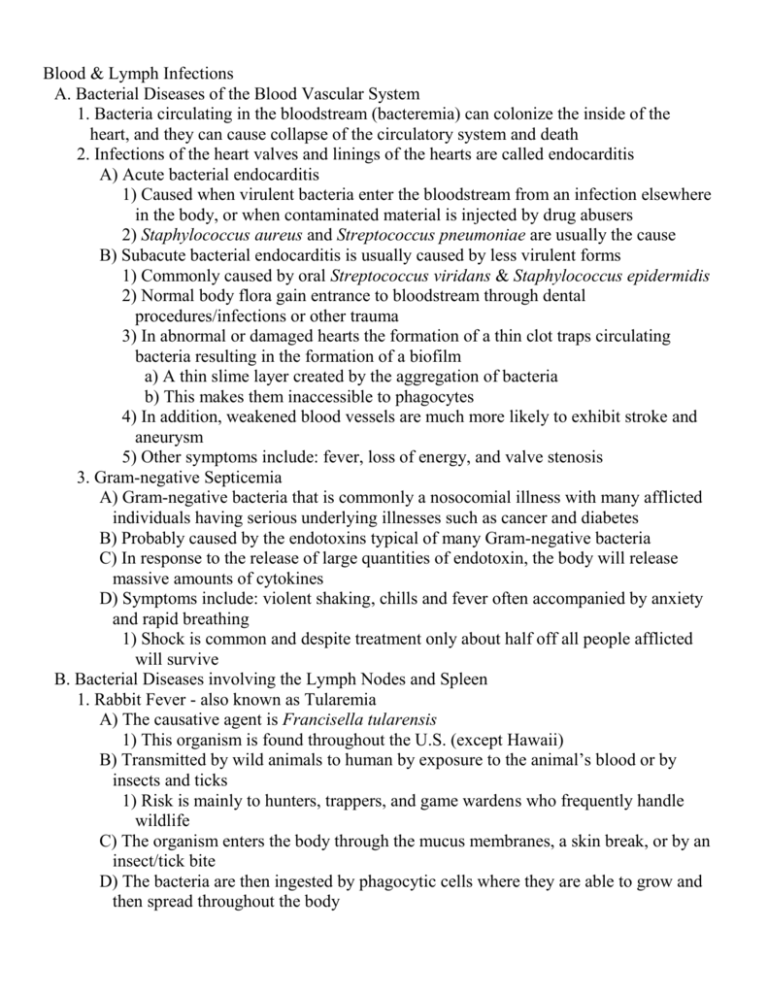
Blood & Lymph Infections A. Bacterial Diseases of the Blood Vascular System 1. Bacteria circulating in the bloodstream (bacteremia) can colonize the inside of the heart, and they can cause collapse of the circulatory system and death 2. Infections of the heart valves and linings of the hearts are called endocarditis A) Acute bacterial endocarditis 1) Caused when virulent bacteria enter the bloodstream from an infection elsewhere in the body, or when contaminated material is injected by drug abusers 2) Staphylococcus aureus and Streptococcus pneumoniae are usually the cause B) Subacute bacterial endocarditis is usually caused by less virulent forms 1) Commonly caused by oral Streptococcus viridans & Staphylococcus epidermidis 2) Normal body flora gain entrance to bloodstream through dental procedures/infections or other trauma 3) In abnormal or damaged hearts the formation of a thin clot traps circulating bacteria resulting in the formation of a biofilm a) A thin slime layer created by the aggregation of bacteria b) This makes them inaccessible to phagocytes 4) In addition, weakened blood vessels are much more likely to exhibit stroke and aneurysm 5) Other symptoms include: fever, loss of energy, and valve stenosis 3. Gram-negative Septicemia A) Gram-negative bacteria that is commonly a nosocomial illness with many afflicted individuals having serious underlying illnesses such as cancer and diabetes B) Probably caused by the endotoxins typical of many Gram-negative bacteria C) In response to the release of large quantities of endotoxin, the body will release massive amounts of cytokines D) Symptoms include: violent shaking, chills and fever often accompanied by anxiety and rapid breathing 1) Shock is common and despite treatment only about half off all people afflicted will survive B. Bacterial Diseases involving the Lymph Nodes and Spleen 1. Rabbit Fever - also known as Tularemia A) The causative agent is Francisella tularensis 1) This organism is found throughout the U.S. (except Hawaii) B) Transmitted by wild animals to human by exposure to the animal’s blood or by insects and ticks 1) Risk is mainly to hunters, trappers, and game wardens who frequently handle wildlife C) The organism enters the body through the mucus membranes, a skin break, or by an insect/tick bite D) The bacteria are then ingested by phagocytic cells where they are able to grow and then spread throughout the body E) Symptoms include headache, fever, chills, and weakness 1) Can also result in skin lesions, swollen lymph glands, conjunctival inflammation, sore throat, and intestinal disruption 2. Brucellosis A) Also called Bang’s Disease or Undulant Fever B) Caused by Brucella melitensis acquired from cattle or other domesticated animals C) Transmitted to humans via the blood of infected animals or contaminated animal products 1) Commonly via occupational exposure in slaughter houses, meat-packing plants, and veterinary practices 2) A small number of cases have been traced to drinking contaminated milk D) Bison, elk, and moose are common carriers and can transmit the bacteria to cattle when grazing land is shared E) The bacteria enters through damaged skin or mucus membranes of the digestive tract, conjunctiva, and respiratory tract F) After reaching the bloodstream in can cause infections in the liver, spleen, bone marrow, and kidneys 1) Often accompanied by profuse sweating, chills, headache, muscle pain, weakness, & weight loss 3. Plague A) Sometimes called “Black death”, it was responsible for the death of approximately one-fourth of the population of Europe from 1346-1350 B) Once a pandemic it is now endemic only in areas with high rodent populations including Western U.S. C) This zoonoses is caused by Yersinia pestis which is an enterobacterium with many virulence factors 1) Pla – protease that destroys C3b and C5a 2) Yops – proteins that interfere with phagocytosis 3) PsaA – an adhesin that plays a role in attachment to host cells D) It is transmitted to humans by fleas (bubonic plague) or from person to person via sputum (pneumonic plague) E) Untreated bubonic plague has a mortality rate of 50-80% and untreated pneumonic plague is fatal at almost 100% 4. Cat Scratch Disease (CSD; cat scratch fever) A) A zoonotic infection primarily seen in children ages 2-14 B) Causitive agent is Bartonella henselae C) Transmitted to humans via bites or scratches by cats, especially kittens 1) About 40% of cats harbor the pathogen D) Symptoms usually present 1-2 weeks after the bite or scratch 1) initially see a cluster of small papules at the site of inoculation 2) followed by swelling of lymph nodes which can become pus-filled 3) only about 1/3 of patients actually experience a fever E) will usually resolve itself without treatment but multiple antibiotics are effective against the pathogen 1) thorough cleaning of a cat bite or scratch will usually prevent the infection C. Viral Diseases of the Lymphatic and Vascular Systems 1. Infectious mononucleosis A) Commonly called “mono” or Kissing disease 1) The incidence of mono is high in populations age 15-24 and most of these individuals become lifelong carriers capable of transmitting the disease via their saliva B) The causative agent is the Epstein-Barr virus (EBV) 1) A DNA virus of the herpesvirus family 2) Establishes an infection of the B-lymphocytes a) certain strains of EBV can cause cancer of the B-cells = Burkitt’s lymphoma C) Symptoms include fatigue, fever, sore throat, and enlargement of the lymph nodes 2. Yellow fever A) Yellow fever is a zoonoses transmitted to humans by mosquitoes B) It is caused by the yellow fever virus C) Infection primarily exists in tropical jungles of Central and South America and Africa D) 85% of patients stay in the acute phase and recover without complication E) The remaining 15% enter into a toxic phase with more severe symptoms 1) The mortality rate can reach as high as 50% in the toxic phase F) Symptoms include headache, high fever, jaundice, and black vomit 1) Severe cases also see loss of kidney function D. Protozoan Diseases of the Blood and Lymphatic System 1. Malaria A) It is the most widespread of all infectious diseases but malaria is now confined to impoverished warm regions of the world where it survives despite the massive eradication programs 1) There are an estimated 300-500 million people infected annually with 3 million deaths B) Caused by multiple members of the Plasmodium family 1) P. malariae, P. vivax, P. falciparum, & P. ovale C) Primarily spread by mosquitoes D) Parasite development is divided into 2 distinct phases 1) Asexual phase – in human host a) Begins when an infected mosquito bites a human b) Before drawing blood, the mosquito injects saliva into the blood to prevent clotting c) Asexual cells known as sporozoites contained in the mosquito’s saliva enter the human host d) The sporozoites move into the liver where they divide within the hepatocytes creating daughter merozoites i) This is known as the exoerythrocytic phase e) The hepatocytes eventually burst releasing the merozoites into the circulation f) Once in the bloodstream, the merozoites move into the RBC and feed on the hemoglobin and reproduce until the RBC bursts i) This is known as the erythrocytic phase g) The merozoites then differentiate into macrogametocytes (female) and microgametocytes (male) gametes 2) Sexual phase – in mosquito host a) A mosquito draws infected blood into its stomach b) Once in the stomach, the micro & macrogametocytes merge creating a new diploid cell (oocyst) that implants in the stomach wall c) The oocyst undergoes meiosis and the resulting cells (sporozoites) move to the salivary glands and wait to be passed on to a human host E) Initial symptoms include violent chills, fever, and sweating often followed by the patient feeling better for short periods F) Hemolytic anemia, ruptured organs, and pulmonary failure may result in more serious cases G) Treatment often involves the use of quinine (a plant extract) or chloroquine 2. African sleeping sickness A) Caused by Trypanosoma brucei B) The causative agent is transmitted to humans via the bite of a tsetse fly C) There are two common subspecies: 1) T. brucei rhodesiense infection is more severe with heart and brain invasion within 6 weeks of infection a) The patient usually dies of heart failure within 6 months 2) T. brucei gambiense infection progresses more slowly and years may pass before death occurs, often from secondary infection a) Human to human transmission is more common than animal to human in the Gambian form D) Initially the organism multiplies in the skin at the site of infection but within a few weeks it enters the lymphatics and blood circulation E) Once the nervous system is involved the patient experiences uncontrollable sleepiness, headache, poor concentration, unsteadiness, coma, and death 3. Elephantiasis (lymphatic filariasis) A) Caused by Wuchereria bancrofti B) Transmitted from human to human via mosquitoes C) Infections of the lymph nodes results in the blockage of normal lymph flow 1) This, in turn, causes fluid to collect (and massive edema) in the lower regions of the body, especially in the lower legs 2) In males, edema may also be seen in the scrotum

